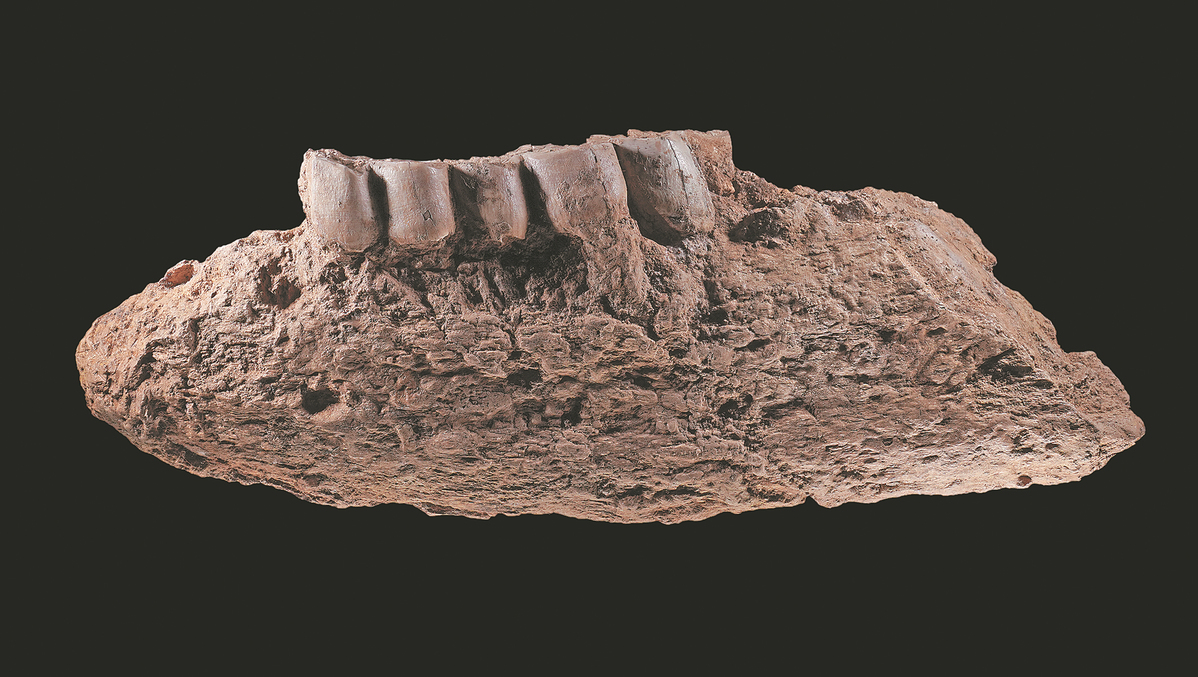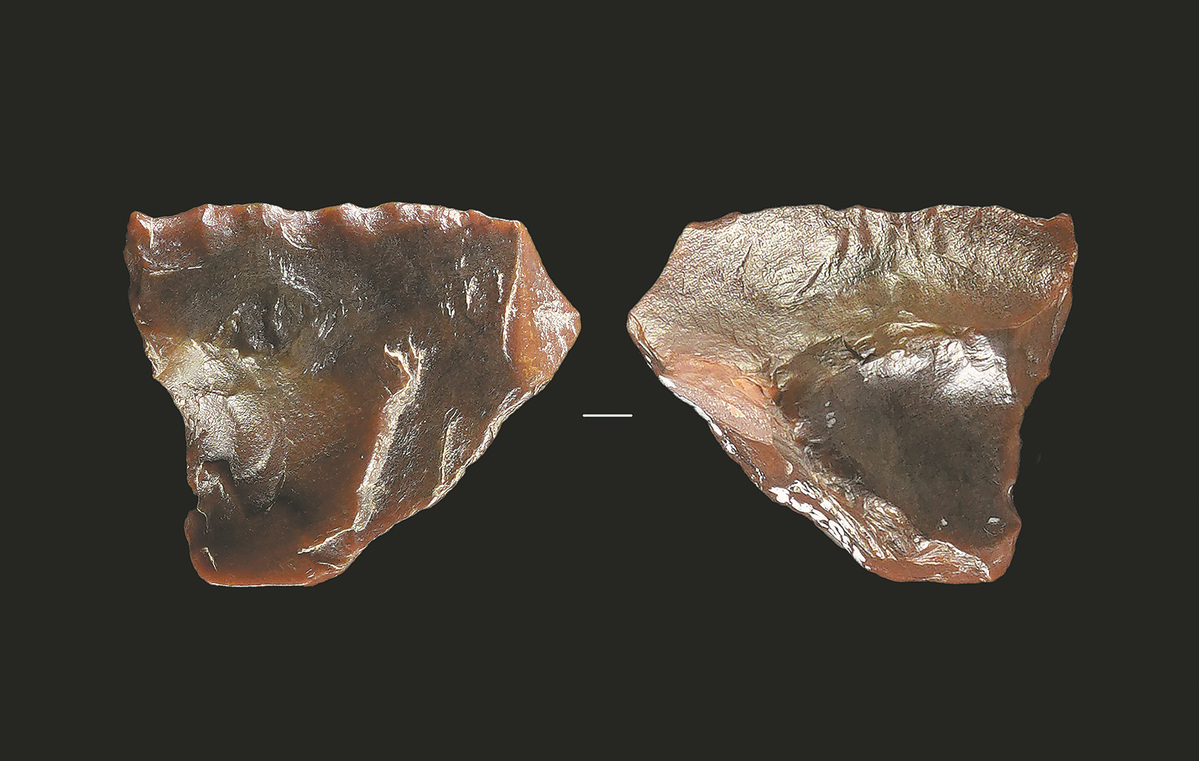Paleolithic site sheds light on human origins

The fossilized mandibular bone of a rhino, awls made of bones and scrapers are among the findings unearthed from the Paleolithic Mengxihe site. CHINA DAILY
The discovery of the Paleolithic Mengxihe site in Ziyang, Sichuan province, was declared as one of the six most important archaeological finds in China last year at an archaeology forum organized by the Chinese Academy of Social Sciences on Tuesday.
The Mengxihe site dates back 50,000 to 70,000 years, and has yielded abundant stone, bone and wooden tools, fossils of more than 30 types of animals including bear, fish and bird, a wide range of plant remains and traces of human activities like carvings, cuttings and use of fire.
It is one of the richest Paleolithic sites in terms of material remains and elements related to human activities, said Zheng Zhexuan, director of the Paleolithic Archaeology Institute at the Sichuan Provincial Institute of Cultural Relics and Archaeology.
The site was discovered in 2021 when the embankment near it got flooded, washing out animal fossils and ebony remains. An archaeological rescue effort was then carried out by the Sichuan Provincial Institute of Cultural Relics and Archaeology and the Chinese Academy of Sciences' Institute of Vertebrate Paleontology and Paleoanthropology and from 2022 to 2023.

The fossilized mandibular bone of a rhino, awls made of bones and scrapers are among the findings unearthed from the Paleolithic Mengxihe site. CHINA DAILY
Some 105,000 tools, animal fossils and their fragments have been unearthed at the site, and more than 95 percent of the tools are made from petrified wood that look like stone.
"These (the tools) defy the traditional concept that during the Paleolithic period, stone tools were often small in the northern part of China, while in the southern part they were often big. Among those making big stone tools, the people in Mengxihe also uniquely made small artifacts, and formed a lasting regional tradition," said Zheng.
Wang Youping, an archaeology professor at Peking University, said the abundant plant remains discovered at the site are the first found from this period.
Despite archaeologists recovering more than 30,000 pieces of seed and fruit remains so far, they only represent a very small proportion of all the samples recovered in 2023.
Rudimentary studies found that the plants, including peach, grape, plum, walnut and acorn, were mostly edible.
"Most Paleolithic sites only have stone tools and animal fossils, but this one has a great number of plant remains. We know Paleolithic people lived by hunting and gathering plant-based food. The first theory has been proved by the many animal fossils discovered before, but the latter is being proved for the first time," said Wang.
Zheng from the Sichuan Provincial Institute of Cultural Relics and Archaeology said that plant remains are extremely difficult to preserve, but those at the site were found in a special water-saturated environment.
Ziyang first found fame about 70 years ago upon the discovery of the Ziyang Man, a human skull dating back 40,000 years. The skull is regarded as an important representative of Homo Sapiens in the southern part of China. The Mengxihe site is about 35 kilometers from where the Ziyang Man was found.

The fossilized mandibular bone of a rhino, awls made of bones and scrapers are among the findings unearthed from the Paleolithic Mengxihe site. CHINA DAILY
Discovery of the site enriches people's understanding of the spread of Homo Sapiens, said Wang from Peking University. One theory posits that about 70,000 years ago, a super volcanic eruption at the present-day Lake Toba in Indonesia caused a devastating cooling episode. It is believed people on other continents besides Africa mostly died during the freeze, and after the episode, Homo Sapiens left Africa and began to spread around the world.
The Mengxihe site may provide new evidence for this theory. "The site dates back roughly to this time, when it was very cold. But the abundant cultural relics show human activities didn't cease then in East Asia, and their society seems to have been prosperous," said Wang.
The site contains various traces of ancient humans' complicated activities, like their development and use of bone and wooden artifacts, use of animals and plants, and carvings on bones, stones and acorns. Many of them were previously believed to have appeared much later, showing a complicated Paleolithic society that may be underestimated, said Zheng.
"It is one of the most systematic and all-element Paleolithic sites in China, showing the relationship between humans and the environment, and providing a vivid view of human activities during the Late Pleistocene epoch," said Wang.
The other finds that were honored at Tuesday's function included the discoveries at a series of Neolithic sites dating back 3,000 to 7,500 years in Pingtan county, Fujian province; the Qujialing Neolithic site dating back 4,200 to 5,900 years in Jingmen, Hubei province; the Zhaigou site dating back to the Shang Dynasty (c.16th century-11th century BC) in Qingjian county, Shaanxi province; the Xipang site in Turpan, Xinjiang Uygur autonomous region, from the Tang Dynasty (618-907) to the Song Dynasty (960-1279); and the Shangjing city of the Liao Dynasty (916-1125) in Baarin Left Banner, Inner Mongolia autonomous region.
Photos
Related Stories
- New finds in China's Guizhou indicate prehistoric human activity over 55,000 years ago
- Paleolithic site found in SW China
- Over 2,000-year-old trench-enclosed tombs discovered in Inner Mongolia
- Archaeologists discover ancient pottery workshop in China's Shaanxi
- China announces six prominent archaeological findings of 2023
- New findings unveil stone processing practices of China's Liangzhu civilization
Copyright © 2024 People's Daily Online. All Rights Reserved.









